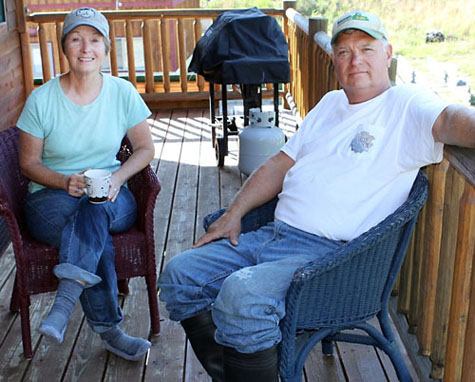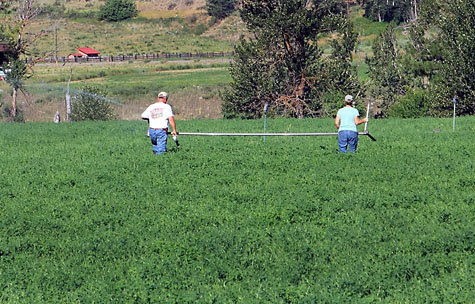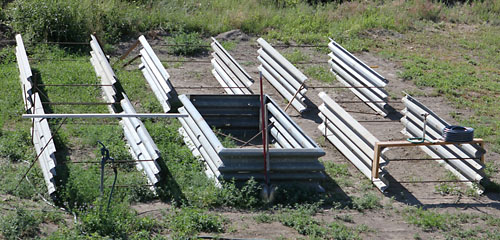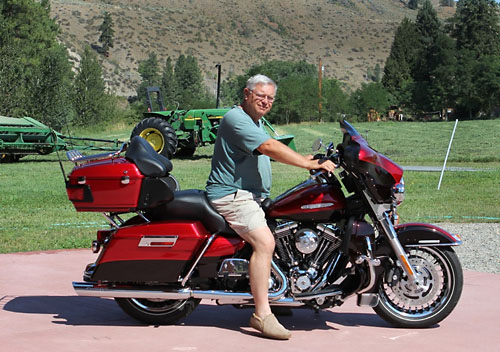home | internet service | web design | business directory | bulletin board | advertise | events calendar | contact | weather | cams

|
Small farming in the Methow PART TWO OF A SERIES Robert and Christie Nolin lived and worked on the west side of the Cascade mountain range, but while their children were growing up they came to the Methow year after year to camp up the Chewuch River. For nearly another decade they rented a cabin south of Winthrop every summer. And eventually, they bought 10.5 acres of onetime orchard land on a bench north of Carlton overlooking the Methow River. Photo at Top: The Nolins have been fulltime Methow Valley residents for fewer than two years. Their new house, in the background, was designed to take advantage of the river view and has its main living space on the second story.
 Christie and Robert Nolin take a coffee break on the deck of their house overlooking the Methow River near Carlton. Christie and Robert Nolin take a coffee break on the deck of their house overlooking the Methow River near Carlton. “I existed—working daily—thinking that someday I’d be riding on a John Deere and be a farmer,” said Robert, who worked for Alaska Distributors, a wine and beer distributing company that later was sold and subjected to deep staff cuts. He was among the long-term and older employees whose jobs were eliminated in 2008. These days Robert is a farmer who owns a John Deere, but reality is altering his dream. Christie spent the longest stretch of her professional life working at Fluke Manufacturing in Everett but also at other manufacturing firms. She, too, dreamed of a rural life that perhaps included a lavender farm and time to travel. When Robert’s job disappeared, she kept her work. Then her employer started outsourcing to India. She said she rightly saw “the handwriting on the wall” and on July 1, 2011, her job vanished. Like other local newcomers, the Nolins—both “city people” born and raised with no rural life experience—made the leap into “retirement.” They had a house built with a lovely view overlooking the Methow River, plus an outbuilding with a large shop. About a year and a half ago, the couple moved to the valley fulltime. Like her husband, Christie had to revamp her rural dream because the lavender farm didn’t pencil out, and farm chores have curtailed their travel plans. Before the move, they leased the nearly seven acres of their land that’s planted in alfalfa to a local family. Being absentee owners, they figured alfalfa would be “the easiest way to maintain the water rights,” Christie explained. “We knew the neighbors all had horses,” added Robert, “All they talked about was horses, horses, horses.” So he figured they could raise hay and sell it locally, which is pretty much what they are doing.  With Robert on one end and Christie on the other, the Nolins change the hand-line sprinklers that irrigate their seven-acre alfalfa field. With Robert on one end and Christie on the other, the Nolins change the hand-line sprinklers that irrigate their seven-acre alfalfa field.But is it the life of their dreams? No, they say. At age 65 the Nolins have had a steep and sometimes brutal learning curve. Last year, for example, the first year they farmed the land on their own, mold proved heartbreaking. Some of their hay crop molded because it was wet and baled too early and some because it sat on wet ground instead of on pallets, Robert explained. That meant the crop lost nutritional value and had to be sold for less money as cattle—not horse—feed. The couple “tried to make bad better,” as Robert put it, by spreading bales over every inch of gravel at their place and turning them constantly to dry them. It was labor intensive but didn’t help. Instead, he said, they gave their more experienced farming neighbors a good laugh. The Nolins also had to invest in farm equipment, some used, some new, and they made at least one mistake by buying a $2,000 piece of machinery of no use in their soil, Robert said. The physical demands of farming also have been eye-opening. Last year, one customer bought two tons of hay. The Nolins weighed the bales and personally loaded the trailer, trucked it to the buyer and unloaded it themselves. Any bale dropped and broken open, they just gave away. “Last year I made eight to ten mistakes that I won’t make this year,” Robert remarked earlier this year when he and Christie were attending the weekly Sustainable Farming class at TwispWorks. The couple said the course was invaluable because of what they learned, plus for the people contacts they made. At that time the Nolin’s plan for this growing season was to raise alfalfa and their own vegetables.  Christie Nolin’s raised-bed vegetable garden remains a work-in-progress. Christie Nolin’s raised-bed vegetable garden remains a work-in-progress.In the cool air of a recent summer morning, the Nolins were knee-deep in their alfalfa field moving sprinkler pipe. It takes both of them, one at each end of the pipe, to accomplish this daily task. They’ll raise three cuttings of hay again this year, the first of which was baled and under cover before the early July rain-heavy thunderstorms. However, they had to hire two boys to help pick up bales so they could beat the rain, said Robert. That was an unanticipated expense, although he said he was thankful he knew someone to call for help. The first cutting yielded 390 bales at about 50 pounds each. Robert did his second cutting on August 3 and found it to be a thicker crop. He expected it to come in at about 400 bales, or 10 tons. Taking a break on their shady deck, the Nolins talked about how their dream has changed. For one thing, they are more homebound than expected. “We wanted to come over here and take little day trips,” Christie said. “But then you have to find somebody to move your hand lines” and they don’t want to take advantage of their neighbors’ generosity although they have occasionally bartered hay for help with changing sprinklers. Winter, they now realize, is their best time to travel out of the valley. However, winter is off limits for traveling on Robert’s new Harley Davidson motorcycle. They’ve also realized there won’t be large profits from raising alfalfa on seven acres. Robert said two things farm class instructor Curtis Beus said have stuck with him. The first is that in all enterprises, the question is not what you can make, but what will it cost you? And secondly, “Remember that whatever you end up doing, you’re going to be paying retail and selling wholesale.” Robert added that during his earlier working life, time and again he saw good small businesses go under because they were started with an inadequate pot of money to invest up front. So handsome profits are not part of the Nolins’ plan, although a little gain would be welcome to fund a get-a-way trip. With a better quality product to sell, they’ve raised their price from $180 to $200 a ton for hay this year – still cheaper than many growers outside the valley, they said. And, thanks to the class, they know more about marketing. Christie said she has been successfully advertising their hay on the Internet both locally and on Craig’s List.  Robert Nolin on his Harley with his John Deere and second cutting of alfalfa waiting to be baled in the background. Robert Nolin on his Harley with his John Deere and second cutting of alfalfa waiting to be baled in the background.The cost of diesel fuel has been a factor in the budget, Robert said. But he recently signed up for a Pacific Pride plan to purchase diesel for his farm equipment. He thinks the money he saves may offset this year’s higher cost for electricity to pump water. (The Nolins irrigate from a private well.) He said the cost of watering caused one of his neighbors to quit irrigating after two cuttings of alfalfa, but he said he will stick to three. Robert also said he can fix or learn to fix most things. “You have to learn how to do it yourself,” he said. “You can’t afford to hire everything done.” Nor can you get everything done. Christie said that when they sit on their deck to relax and admire the view, “You just sit down and look out and see things you have to do.” The raised-bed vegetable garden, for instance, is a project in its infancy. Christie has never had a garden although she took a local gardening class and very much wants one. Perhaps the empty, unfinished boxes will be ready to plant next year. Building a greenhouse near the raised beds also remains on the future project list. Asked if they have a revised five-year plan, Robert said, only half in jest, “To sell the damn place, get out of here and go to the desert.” Getting more serious, he shared this realization: “We think that one of us can’t do a thing here. It takes both of us. We are 65. We can’t do it forever.” If they stay, they could set up three paddocks and run some cattle, he added. But in four or five years he expects property values to be higher than they are now, meaning it could be a good time to sell. And as a history and antique buff—Christie said Robert “can smell a garage sale a mile away”—Robert fantasizes about loading up a trailer and becoming a traveling antique salesman. “Or just move to some area in the Southwest and rent every place you go,” said Christie, adding, “We’re starting to sober up.” As for the farm dream that sustained Robert for so long, he now says he wants to grow quality hay with consistency. “I want to be as good as people get at it in five years.” Next (in part three): Meet Katie Haven, a retired marine engineer, who shares the 20-year plan for the McFarland Creek Lamb Ranch, where she lives with her partner, Bill Tackman. 8/12/2013 Comments
|
